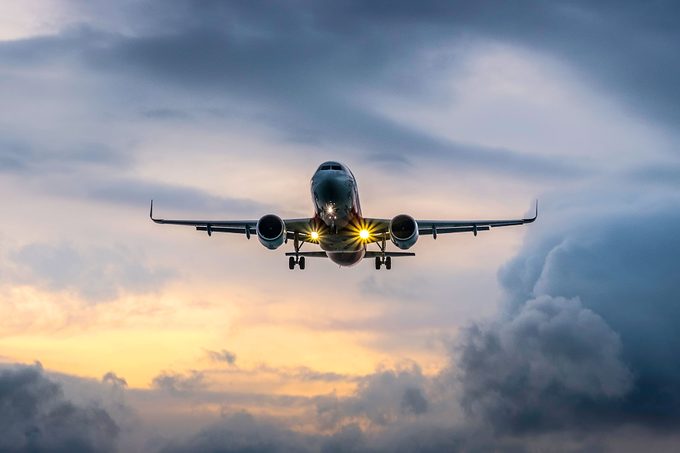The plane is shaking and your drink is spilling. What is turbulence, and should you be worried?

This Is What Really Happens When There’s Turbulence

Forget what you’ll pack in your checked bag. If you’re an anxious flyer, you’re far more concerned about how you’re going to make it from point A to point B without completely freaking out. Throw in a bit of turbulence or rough weather, and the smooth sailing you were crossing your fingers (and toes) for is suddenly out the window.
But what is turbulence, anyway? Turbulence is a constant during air travel, but it can still be frightening and confusing—even for frequent fliers. Are those bumps in the air normal? Are they dangerous?
Reader’s Digest spoke to Richard Gonzales, an experienced pilot and aviation consultant, to give us the scoop on choppy airplane rides. Keep reading to learn how to make your next flight more relaxing, and possibly even stress-free.
Get Reader’s Digest’s Read Up newsletter for more travel, tech, humor, cleaning, and fun facts all week long.
What is turbulence?
According to Gonzales, turbulence is just “rough air.” You’ve probably heard pilots use this descriptor over the intercom when they ask you to keep your seat belt buckled, but what does it mean, exactly? Why is the air rough?
The National Weather Service describes turbulence as an “irregular motion of air resulting from eddies or vertical currents.” (Eddies are circular movements.) It’s these invisible air currents that cause the plane you’re on to bump around—and make you grip the armrest. The Federal Aviation Administration (FAA) describes four levels of turbulence: light, moderate, severe and extreme.
“Light turbulence, often called light chop, feels like rhythmic bumpiness,” Gonzales says. “You won’t have trouble walking around the cabin, and you can expect to see flight attendants out with the service cart.” Moderate turbulence will feel more erratic, and you might also feel strain from your seat belt. “Anticipating this level of turbulence, pilots will turn on the seat belt sign alerting passengers to return to their seats,” Gonzales says.
Light and moderate turbulence are the most common forms of rough air. “Severe turbulence is rare, and comes with short bursts of weightlessness and more strain on your seatbelt,” Gonzales says. “During extreme turbulence, the rarest form of rough air, you will experience violent jolts, and objects in the cabin can get tossed around.”
What causes turbulence?
Whether you experience turbulence depends on several factors, from the temperature to the direction that air is blowing. “As the sun comes up and heats the ground, that hot air (called thermals) rises and mixes with cooler air,” Gonzales says. “The two air masses mixing creates an imbalance, which results in rough air.” He says this type of turbulence typically happens closer to the ground.
“If you’ve ever flown into Las Vegas or Phoenix, you might have felt a bumpy approach due to the desert ground pushing hot air upward,” Gonzales says.
Turbulence can also happen when something gets in the way of airflow. Anything from tall buildings to mountains to trees can impact the way passengers feel aboard the airplane. “As air flows horizontally, anything in its way causes a disruption, leading to rough air,” Gonzales says. “Depending on the aircraft’s altitude, crossing the Rockies will most likely bring turbulence.”
Is turbulence dangerous?

Not typically. Gonzales says turbulence is normal, and while you may be uncomfortable, you’re most likely safe as long as you’re not up and walking around, or sitting without your seat belt on.
“Pilots use preflight weather briefings to detect turbulence along their route of flight,” he says. “Once airborne, pilots will receive ‘ride reports’ from other aircrew who encountered rough air, so they have time to coordinate a path around the turbulence.”
“In all, there’s a robust network of weather experts, air traffic controllers and pilots working together to ensure the smoothest flight for everyone,” Gonzales says. “Sometimes it’s unavoidable to fly through light and moderate turbulence, but rest assured your pilots are working to find smooth air.” When pilots encounter severe or extreme turbulence, especially if it’s not forecasted, they quickly look for a safer altitude.
What should you do during turbulence?
Listen to the pilots and flight attendants, and take your cues from them. Keep your seatbelt on. If you’re stressed while flying, Gonzales says to watch the flight attendants when turbulence is going down. If they’re relaxed and continuing their cart service, it’s nothing to be worried about.
Another option is to take a look at the passengers in front of you: “Gauge the bobbling heads in front of you. While funny to watch, it’s also a good indicator of rough air,” Gonzales says. “If the turbulence gets serious, you’ll see those passengers who didn’t fasten their seat belts come up out of their seats.”
If the ride is really rough, remember that planes are built to withstand even the harshest turbulence. The reason people get injured from turbulence isn’t because the plane is in danger. It’s because they don’t have their seatbelt on and they get thrown around. So stay seated and listen to the advisories. “Remember, pilots and flight attendants want passengers to enjoy their flight, and [they] understand the uneasiness turbulence causes,” Gonzales says.
About the expert
|
Why trust us
Reader’s Digest has published hundreds of travel stories that help readers explore the world safely, easily and affordably. We regularly cover topics such as the best places to visit (and the best times to visit them), tips and tricks to zoom through airport security, flight-attendant secrets, hotel-room hacks and more. We’re committed to producing high-quality content by writers with expertise and experience in their field in consultation with relevant, qualified experts. We rely on reputable primary sources, including government and professional organizations and academic institutions as well as our writers’ personal experiences where appropriate. We verify all facts and data, back them with credible sourcing and revisit them over time to ensure they remain accurate and up to date. Read more about our team, our contributors and our editorial policies.
Sources:
- FAA: “Pilot Weather Reports”
- National Weather Service: “Turbulence”
- New York Times: “Fasten Your Seatbelts: What You Need to Know About Turbulence”
- Richard Gonzales, pilot and aviation consultant






















